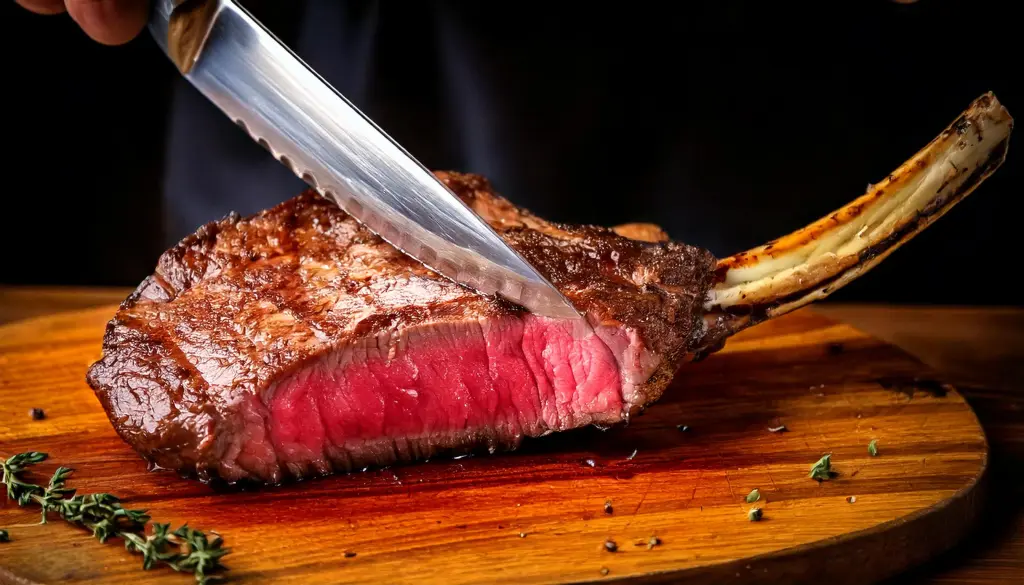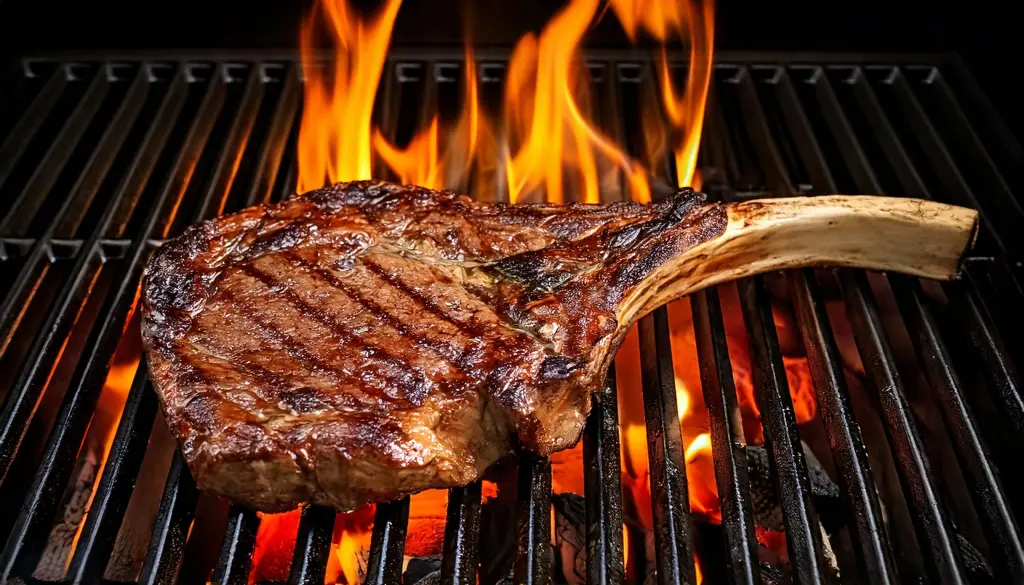Why Is Tomahawk More Expensive Than Ribeye? Steak lovers everywhere marvel at the sight of a beautifully presented tomahawk steak it’s luxurious, impressive, and undeniably pricey. But why exactly does the tomahawk command such a premium price compared to the ribeye? In this article, we’ll dive into everything from the unique anatomy of these cuts to factors like preparation, flavor, and rarity. By the end, you’ll understand what sets tomahawk steaks apart and whether they’re worth the splurge.
What Is a Tomahawk Steak?
The Anatomy of a Tomahawk Steak
Tomahawk steaks are essentially ribeye steaks with a dramatic, long, frenched bone attached. This bone, cleaned of its meat and fat, gives the cut its striking resemblance to a tomahawk axe hence the name. The steak comes from the rib primal section of the cow, the same area as ribeye, but its preparation elevates it to a premium level.
The frenched bone isn’t just for looks. It adds weight and contributes to the steak’s overall size, which can be intimidatingly large. A tomahawk steak often weighs around 30-45 ounces, dwarfing the average ribeye.
The Visual Appeal and Presentation
The iconic presentation is one of the tomahawk’s major selling points. Restaurants and steakhouses love showcasing this cut because it practically screams indulgence. Imagine it being served on a sizzling platter, the massive bone sticking out dramatically it’s an instant crowd-pleaser.
That visual appeal translates directly to price. Customers pay for the experience as much as the steak itself, making tomahawk steaks a staple in high-end dining.
What Is a Ribeye?
On the other hand, ribeye steaks while coming from the same rib primal lack the long bone. Ribeyes are boneless or may sometimes include a small portion of the rib bone, making them simpler to prepare and more compact. While they’re rich in marbling and tenderness, their presentation doesn’t carry the same flair as the tomahawk, which often impacts their pricing.
Factors Behind Why Is Tomahawk More Expensive Than Ribeye?
The Role of the Frenched Bone
One of the primary reasons why tomahawk steaks are more expensive than ribeye is the labor-intensive process of frenching the bone. This involves scraping away the meat and fat from the bone to create that clean, elegant look. It’s not just about aesthetics this preparation requires skill and time, both of which add to the steak’s overall cost.
Interestingly, the bone itself doesn’t directly contribute to the flavor, but its presence makes the steak visually striking, justifying the higher price tag in restaurants and gourmet butcher shops.
Size and Weight Differences
Another factor contributing to the tomahawk’s premium price is its size. These steaks are massive, often weighing twice as much as a standard ribeye. That extra weight doesn’t come cheap! Restaurants and suppliers price tomahawks by the pound, so their larger size naturally means a heftier price tag.
This larger portion also means that tomahawks are often shared or served as centerpieces in fine dining. The experience of eating one becomes part of its value, unlike the more modest ribeye.
Rarity and Scarcity
Cows don’t produce endless tomahawk steaks. For every cow, only a limited number of ribeye cuts can be turned into tomahawks. This scarcity contributes to the exclusivity and higher cost. Ribeye, on the other hand, is far more common, making it a less extravagant but still excellent choice for steak lovers.
Premium Grading and Standards
Tomahawk steaks are frequently made from the highest grades of beef, such as USDA Prime or Wagyu. These grades boast superior marbling, tenderness, and flavor. The luxurious texture and rich taste of high-grade tomahawk steaks elevate their status and their price. When you combine premium beef with a unique presentation, you’re paying for the best of the best.
For more on what makes beef cuts special, check out :BBQ Host
Flavor and Texture Differences Between Tomahawk and Ribeye

The Impact of Marbling on Flavor
Both tomahawk steaks and ribeyes are known for their exceptional marbling, which is the distribution of intramuscular fat throughout the meat. However, tomahawk steaks often come from beef graded at the highest levels, like USDA Prime or Wagyu, which ensures an even richer flavor and buttery texture.
The marbling in these cuts melts as the steak cooks, basting the meat from within and creating a juicy, tender bite. While ribeye also offers excellent marbling, it’s the overall size and cut of the tomahawk that amplifies its indulgence factor, giving you that melt-in-your-mouth sensation in every bite.
Bone-In vs. Boneless Cooking
Tomahawk steaks are bone-in, which plays a role in their cooking and flavor. The long rib bone acts as a heat buffer, allowing the meat to cook more evenly and retain its juiciness. While the bone itself doesn’t add a significant amount of flavor, many chefs and steak enthusiasts argue that it contributes to the overall cooking experience and presentation.
On the other hand, ribeye steaks are often sold boneless, making them quicker and easier to cook. They deliver similar flavor profiles but lack the dramatic flair and slight textural nuances associated with bone-in tomahawk cuts.
Texture: Tenderness and Bite
Due to their high-fat content and prime grading, tomahawk steaks boast a tender yet substantial texture. The rich fat cap and evenly marbled meat ensure that every bite is bursting with flavor. Ribeye shares many of these qualities but might feel slightly less decadent due to its smaller size and simpler preparation.
Tomahawk steak cost Production and Distribution
Labor Costs in Preparing Tomahawk Steaks
Preparing a tomahawk steak isn’t as simple as cutting meat. Butchers spend extra time frenching the bone, which requires precision and skill to give the cut its signature look. This additional labor significantly increases the cost compared to a standard ribeye. While ribeyes are straightforward to process and package, tomahawks demand more attention to detail, which adds to their price.
Moreover, the size of tomahawk steaks means they require special packaging and handling during distribution. Their long bone doesn’t fit standard containers, further complicating logistics and pushing costs higher.
Premium Sourcing of Tomahawk Cuts
Tomahawk steaks are often sourced from the highest-quality cattle breeds, such as Black Angus or Wagyu. These breeds are raised under strict conditions to ensure exceptional meat quality, which includes carefully controlled diets and stress-free environments. This premium sourcing directly impacts the price, making tomahawks a luxury product.
In contrast, ribeyes are more commonly found across various grades and can be sourced from more standard beef breeds, making them more accessible and affordable.
Restaurant Markups
When dining out, the cost of a tomahawk steak can soar due to hefty restaurant markups. High-end steakhouses often charge several times the wholesale price for tomahawk steaks, banking on the steak’s visual appeal and the “wow factor” it provides to diners. Ribeye steaks, while still a favorite, don’t offer the same spectacle and are priced more modestly on most menus.
The Role of Marketing and Prestige, tomahawk vs ribeye
Tomahawk Steaks as a Status Symbol
The tomahawk steak’s grandeur makes it more than just food it’s a statement. Restaurants and marketers use this dramatic cut to symbolize luxury and exclusivity, turning it into a must-have for special occasions or indulgent dining experiences. That marketing appeal plays a huge role in the price difference between tomahawk and ribeye.
When a steak is presented with its long bone and sizzling on a platter, it creates an unforgettable experience. The unique aesthetic makes tomahawk steaks highly Instagrammable, further driving their demand. Ribeye, while equally delicious, doesn’t carry the same level of visual or social prestige.
Marketing Tactics in High-End Restaurants
Restaurants often highlight tomahawk steaks as a centerpiece of their menus. These cuts are intentionally marketed as premium items, meant to evoke feelings of indulgence and exclusivity. The high price tag reinforces their status as a luxury product, creating the perception that tomahawk steaks are worth splurging on.
The Power of Perception
Consumers associate price with quality, and tomahawk steaks are no exception. Their higher cost is often seen as a marker of superior flavor, craftsmanship, and uniqueness. Even though ribeye provides a similar eating experience, it lacks the same “wow” factor that tomahawks offer.
Visual Appeal and Dining Experience
The Presentation of Tomahawk Steaks
Tomahawk steaks are renowned for their stunning presentation. The long bone protruding from the cut gives it a dramatic, almost primal appearance that elevates any dining table. Whether served on a sizzling platter or carved tableside, the tomahawk offers a visual spectacle that ribeye simply can’t replicate.
This extraordinary presentation adds to its perceived value, as diners are often willing to pay more for an experience that feels unique and memorable. Ribeye, on the other hand, is typically served as a simple plate of steak, lacking the flair that tomahawk delivers.
The Experience of Sharing
A tomahawk steak is often designed to be shared, creating a communal dining experience. Its size and showmanship make it the perfect centerpiece for celebrations or special occasions. The process of carving and serving a tomahawk adds to its charm, turning a simple meal into a social event.
Ribeye, while still a favorite for steak lovers, is more personal in nature and doesn’t carry the same sense of grandeur or group appeal.
Restaurant Rituals
Many high-end steakhouses incorporate rituals when serving tomahawk steaks, such as flambéing or presenting the steak with an explanation of its origin. These added touches enhance the overall dining experience, justifying the premium cost.
Availability and Accessibility

Limited Availability of Tomahawk Steaks
Tomahawk steaks are not as widely available as ribeye cuts. This is partly due to the extra preparation required and the fact that only a small portion of the rib primal can be processed into tomahawk cuts. Butchers must preserve the long bone, which limits how many tomahawk steaks can be created from a single steer.
On the other hand, ribeye steaks are one of the most common and versatile cuts in the beef market. They are readily available at grocery stores, butcher shops, and restaurants, making them a more accessible option for the average consumer.
Export and Regional Variations
In some regions, tomahawk steaks are considered a specialty item and are often imported, further driving up their cost. For example, imported Wagyu tomahawk steaks can cost significantly more due to shipping, tariffs, and exclusivity.
Ribeye, by contrast, is more globally available, making it a staple in households and restaurants worldwide. The broader availability reduces its price compared to the premium niche that tomahawk occupies.
Impact on Home Cooks
While ribeye is popular for home grilling or pan-searing, the sheer size and cost of a tomahawk steak often make it intimidating for home cooks. Its price and unique preparation needs (like fitting it into a standard grill or oven) mean that tomahawk steaks are often reserved for special occasions or professional chefs, reinforcing their luxury status.
FAQs: Common Questions About Tomahawk and Ribeye Steaks
Why Is a Tomahawk Steak So Expensive Compared to Ribeye?
Tomahawk steaks are more expensive due to their dramatic presentation, additional labor required for preparation, limited availability, and premium sourcing. The bone-in cut and extra processing, along with their exclusivity, justify the higher price.
Does the Bone in a Tomahawk Steak Add Flavor?
While the bone itself doesn’t directly infuse flavor into the meat, it acts as a heat insulator during cooking, helping the steak retain moisture and cook evenly. Additionally, the bone contributes to the steak’s visual appeal, making it a centerpiece-worthy cut.
Can You Cook a Tomahawk Steak at Home?
Yes, tomahawk steaks can be cooked at home, though their size can make it challenging. You’ll need a grill or oven large enough to accommodate the long bone. Techniques like reverse searing or grilling over indirect heat work well to ensure even cooking.The Ultimate Guide to Cooking a Perfect Cowboy Steak: Tips & Recipes.
Is Ribeye Just as Tender as Tomahawk?
Yes, both cuts come from the same rib primal and share similar marbling, which makes them equally tender and flavorful. The difference lies in the presentation and cooking process, as the tomahawk’s bone can enhance the experience.
Are Tomahawk Steaks Worth the Price?
It depends on the occasion. If you’re looking for a luxurious and visually impressive steak for a special event, the tomahawk is worth the splurge. However, for everyday cooking, ribeye offers a similar taste and texture at a more affordable price.
What’s the Best Way to Serve a Tomahawk Steak?
Tomahawk steaks are often served as a show-stopping centerpiece, carved tableside or plated with simple sides like mashed potatoes and roasted vegetables. Their presentation enhances the overall dining experience.
Conclusion: Why Tomahawk Is Pricier Than Ribeye
When it comes to tomahawk steaks and ribeye, the difference in price boils down to more than just the cut of meat. Tomahawk steaks offer a unique blend of aesthetics, dining experience, and perceived exclusivity that ribeye doesn’t provide. From their dramatic bone-in presentation to the additional labor involved in their preparation, these elements combine to justify the higher price tag.
On the other hand, ribeye is the reliable, accessible option for those who want the same tender, marbled flavor without the premium cost or visual flair. Choosing between these two cuts depends on what you value more luxury and presentation or simplicity and affordability.
Ultimately, whether you opt for a tomahawk steak to impress at a special occasion or stick to a ribeye for weeknight grilling, both cuts guarantee a delicious, flavorful experience. It’s a matter of taste, budget, and, of course, the occasion.
